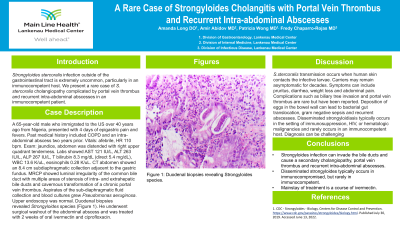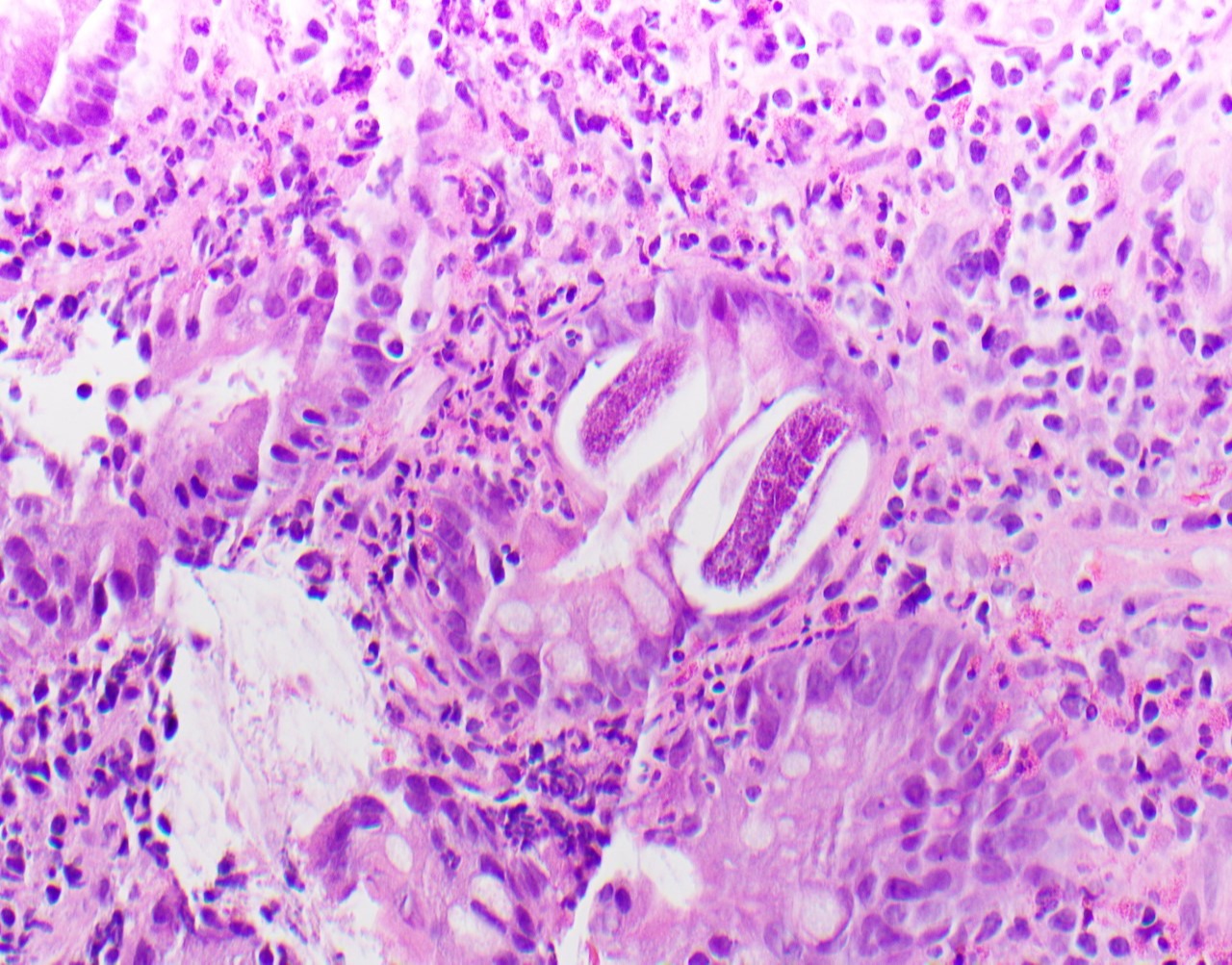Back


Poster Session C - Monday Afternoon
Category: Biliary/Pancreas
C0041 - A Rare Case of Strongyloides Cholangitis With Portal Vein Thrombus and Recurrent Intra-Abdominal Abscesses
Monday, October 24, 2022
3:00 PM – 5:00 PM ET
Location: Crown Ballroom

Has Audio
- AL
Amanda Long, DO
Lankenau Medical Center
Wynnewood, PA
Presenting Author(s)
Amanda Long, DO1, Amir Abidov, DO1, Fredy Chaparro-Rojas, MD1, Patricia Wong, MD2
1Lankenau Medical Center, Wynnewood, PA; 2Lankenau Medical Center, Philadelphia, PA
Introduction: Strongyloides stercoralis infection outside of the gastrointestinal tract is extremely uncommon, particularly in an immunocompetent host. We present a rare case of S. stercoralis cholangitis complicated by portal vein thrombus and recurrent intra-abdominal abscesses in an immunocompetent patient.
Case Description/Methods: A 65-year-old male who immigrated to the United States (US) over 40 years prior from Nigeria, presented with 4 days of epigastric pain, weakness, fevers and anorexia. His medical history was notable for COPD and an intra-abdominal abscess two years prior. His previous abscess was treated with percutaneous drainage and antibiotics. On arrival, he was afebrile and tachycardic to 110 bpm. He appeared jaundiced, and his abdomen was distended with right upper quadrant tenderness. Labs showed AST 121 IU/L, ALT 263 IU/L, ALP 267 IU/L, total bilirubin 8.3 mg/dL (direct 5.4 mg/dL), WBC 13.6 K/uL, eosinophils 0.28 K/uL. Non-contrast-enhanced abdominal computerized tomography (CT) scan showed an 8.4 cm subdiaphragmatic collection adjacent to the gastric fundus and intra- and extrahepatic ductal dilation. MRCP showed luminal irregularity of the common bile duct with multiple areas of stenosis of intra- and extrahepatic bile ducts and cavernous transformation of a chronic portal vein thrombus. Aspirates of the sub-diaphragmatic fluid collection and blood cultures grew Pseudomonas aeruginosa. Intravenous piperacillin-tazobactam was started. Upper endoscopy and endoscopic ultrasound of the stomach showed normal gastric and duodenal mucosa with multiple large periduodenal varices. Duodenal biopsies revealed Strongyloides species (Figure 1). S. stercoralis serologies were positive and HIV antibodies were negative. He underwent surgical washout of the abdominal abscess and was treated with 2 weeks of oral ivermectin and ciprofloxacin.
Discussion: S.stercoralis transmission occurs when human skin contacts the infective larvae. Carriers may remain asymptomatic for decades. Symptoms can include pruritus, diarrhea, weight loss and abdominal pain. Complications such as biliary tree invasion and portal vein thrombus are rare but have been reported. Deposition of eggs in the bowel wall can lead to bacterial gut translocation, gram negative sepsis and recurrent abscesses. Disseminated strongyloidiasis typically occurs in the setting of immunosuppression, HIV, or hematologic malignancies and rarely occurs in an immunocompetent host. Diagnosis can be challenging.

Disclosures:
Amanda Long, DO1, Amir Abidov, DO1, Fredy Chaparro-Rojas, MD1, Patricia Wong, MD2. C0041 - A Rare Case of Strongyloides Cholangitis With Portal Vein Thrombus and Recurrent Intra-Abdominal Abscesses, ACG 2022 Annual Scientific Meeting Abstracts. Charlotte, NC: American College of Gastroenterology.
1Lankenau Medical Center, Wynnewood, PA; 2Lankenau Medical Center, Philadelphia, PA
Introduction: Strongyloides stercoralis infection outside of the gastrointestinal tract is extremely uncommon, particularly in an immunocompetent host. We present a rare case of S. stercoralis cholangitis complicated by portal vein thrombus and recurrent intra-abdominal abscesses in an immunocompetent patient.
Case Description/Methods: A 65-year-old male who immigrated to the United States (US) over 40 years prior from Nigeria, presented with 4 days of epigastric pain, weakness, fevers and anorexia. His medical history was notable for COPD and an intra-abdominal abscess two years prior. His previous abscess was treated with percutaneous drainage and antibiotics. On arrival, he was afebrile and tachycardic to 110 bpm. He appeared jaundiced, and his abdomen was distended with right upper quadrant tenderness. Labs showed AST 121 IU/L, ALT 263 IU/L, ALP 267 IU/L, total bilirubin 8.3 mg/dL (direct 5.4 mg/dL), WBC 13.6 K/uL, eosinophils 0.28 K/uL. Non-contrast-enhanced abdominal computerized tomography (CT) scan showed an 8.4 cm subdiaphragmatic collection adjacent to the gastric fundus and intra- and extrahepatic ductal dilation. MRCP showed luminal irregularity of the common bile duct with multiple areas of stenosis of intra- and extrahepatic bile ducts and cavernous transformation of a chronic portal vein thrombus. Aspirates of the sub-diaphragmatic fluid collection and blood cultures grew Pseudomonas aeruginosa. Intravenous piperacillin-tazobactam was started. Upper endoscopy and endoscopic ultrasound of the stomach showed normal gastric and duodenal mucosa with multiple large periduodenal varices. Duodenal biopsies revealed Strongyloides species (Figure 1). S. stercoralis serologies were positive and HIV antibodies were negative. He underwent surgical washout of the abdominal abscess and was treated with 2 weeks of oral ivermectin and ciprofloxacin.
Discussion: S.stercoralis transmission occurs when human skin contacts the infective larvae. Carriers may remain asymptomatic for decades. Symptoms can include pruritus, diarrhea, weight loss and abdominal pain. Complications such as biliary tree invasion and portal vein thrombus are rare but have been reported. Deposition of eggs in the bowel wall can lead to bacterial gut translocation, gram negative sepsis and recurrent abscesses. Disseminated strongyloidiasis typically occurs in the setting of immunosuppression, HIV, or hematologic malignancies and rarely occurs in an immunocompetent host. Diagnosis can be challenging.

Figure: Strongyloides organism on duodenal biopsy
Disclosures:
Amanda Long indicated no relevant financial relationships.
Amir Abidov indicated no relevant financial relationships.
Fredy Chaparro-Rojas indicated no relevant financial relationships.
Patricia Wong indicated no relevant financial relationships.
Amanda Long, DO1, Amir Abidov, DO1, Fredy Chaparro-Rojas, MD1, Patricia Wong, MD2. C0041 - A Rare Case of Strongyloides Cholangitis With Portal Vein Thrombus and Recurrent Intra-Abdominal Abscesses, ACG 2022 Annual Scientific Meeting Abstracts. Charlotte, NC: American College of Gastroenterology.
